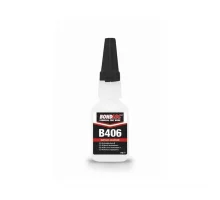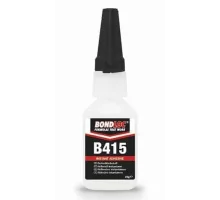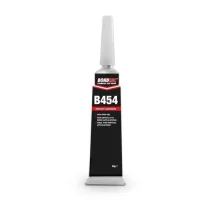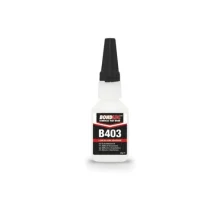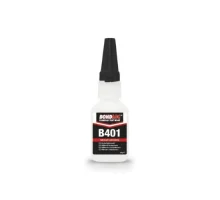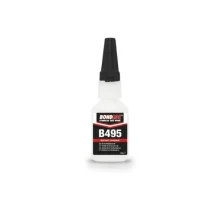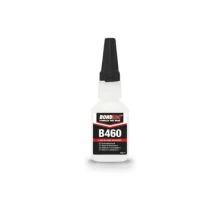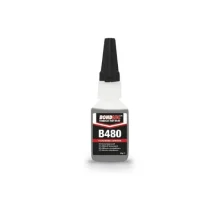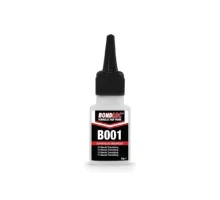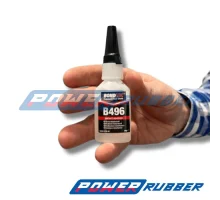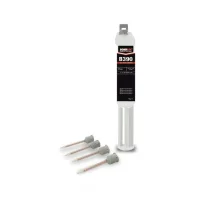Cyanoacrylate Adhesive
Fast-dry Adhesive
Cyanoacrylic adhesive properties
Cyanoacrylic adhesive is a universal adhesive for the combination of rubber elements available in our POWER Rubber rubber store. Glue is the right use for daily use.
Cyanoacrylic adhesive with activator
For special tasks, where the combination of individual elements does not come easily, it easily helps the activator. The combination of cyanoacrylic glue with an activator, allows for extreme joints of rubber mixtures, but also not only. Allows you to combine rubber products with metal and other alloys.
What is cyanoacrylate adhesive?
Quick-setting adhesives (cyanoacrylates) are one-component preparations with varying viscosities designed for fast and reliable bonding of elements made from different materials. Their main component is cyanoacrylate, which transitions into a plastic state after hardening.
Cyanoacrylate adhesive - discover the properties of instant adhesives
Cyanoacrylate adhesives (CA) form strong bonds between rubber and rubber, rubber and metals, plastics, and other materials in just a few seconds. The bond is characterized by high strength and excellent gap-filling ability. Additionally, it is resistant to high temperatures (from -55°C to +120°C) and nonpolar solvents (e.g., hexane, benzene).
Quick-setting adhesive ensures fast curing time at room temperature and high strength on various surfaces. It is odorless and practically free from blooming (white discoloration at the joint). We recommend exploring the remaining benefits and properties of the instant adhesive:
- transparent
- waterproof
- provides strong and durable bonds
- offers incredible bonding speed from 5 to 20 seconds (to achieve full bonding strength, avoid excessive stress on bonded parts)
- great ability to bond gaps
- excellent temperature resistance (from -55°C up to +180°C)
- versatility - used for bonding porous materials, elastic materials, combinations of porous and elastic materials (e.g., wood-rubber), bonding plastics (e.g., polycarbonate)
- bonded joints are resistant to oils, fuels, and moisture
How do cyanoacrylate adhesives work?
Cyanoacrylate adhesives quickly react at room temperature after pressing two surfaces together and harden from the residual moisture naturally present on the surface of materials. This means that the glue can only bond to the surface where moisture is present. If applied to a perfectly dry surface, it will not adhere to it and will not form a bond. Fast-setting adhesives react with moisture to create chains between the two contacting materials, which in turn generates heat and leads to immediate hardening.
The hardening process is important for all types of glue. Fast-setting glue, also known as super glue, is made based on ethyl, methyl, and alkoxy. As mentioned above, the mechanism of hardening cyanoacrylate adhesives is possible due to the presence of moisture and occurs almost instantaneously at room temperature. The glue can produce a specific, sharp odor (particularly noticeable in low humidity conditions). It is harmful to the eyes and mucous membranes.
Cyanoacrylate gel and liquid adhesive - Applications
Cyanoacrylates, also known as cyanoacrylate adhesives, bond well with difficult-to-glue materials (such as PTFE Teflon, polyolefins, PP, and PE, polystyrene), as well as various plastics including NBR, SBR, EPDM, PMMA, plexiglass, rigid PVC, ABS, butyl, polystyrene, and rigid PVC). They are also recommended for bonding porous materials (MDF, wood, cardboard, leather, paper, ceramics) and rubber.
Fast-drying cyanoacrylate adhesive is available in liquid as well as gel form, and comes in various consistencies, such as medium-density.
This universal adhesive has a wide range of applications. The adhesive polymerizes through the catalytic action of moisture present in the air. It is a versatile product for bonding different elements, available in both liquid and gel forms. Cyanoacrylate adhesives produce strong bonds, making them popular for both household applications (e.g., modeling) and industrial uses (e.g., electronic equipment manufacturing, automotive industry, carpentry workshops).
Cyanoacrylate adhesive activator
There is a possibility to speed up the bonding process with cyanoacrylate adhesive using an activator. Activator for cyanoacrylate adhesives should be sprayed onto a thin layer of instant adhesive to help fill gaps quickly and bond surfaces efficiently. Accelerators are commonly used in very cold and dry environmental conditions.
Activator is a product that is generally used between materials that are difficult to bond and other synthetic materials (e.g., polyethylene (PE), polypropylene (PP), silicone rubber, glass).
Cyanoacrylate adhesive for rubber
If you are looking for glue to bond rubber elements and products, the ideal solution is cyanoacrylate adhesive - for rubber. Ideal! It is also worth learning more about what Cyanoacrylate adhesive - price also matters, so check out our price deals.
Cyanoacrylate adhesives are solvent-free and do not react with the glued material. They are characterized by a short reaction time. The chemical reaction of cyanoacrylate with moisture in the air is a matter of seconds. Due to the fast bonding time, it is recommended to use cyanoacrylate adhesive on small surfaces. Adhesives of this type are very versatile, used for bonding rubber, rubber elements, O-rings, as they allow for flexible connection of polymers, as well as glass, wood, paper, leather, or plastics. They can be used to bond small steel or colored metal elements. Joints made with this adhesive are resistant to oils and fuels, additionally characterized by high strength. Cyanoacrylate adhesive is usually transparent, allowing for almost invisible bonding of materials and enhancing the aesthetics of the finished work.
